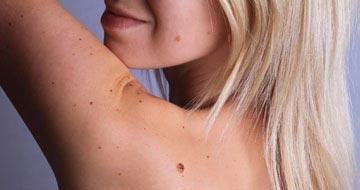Birthmarks
Birthmarks are coloured marks on the skin. They're usually seen from birth but sometimes develop in adulthood. There are many kinds of birthmarks, but they fall into two general types: pigmented birthmarks and vascular birthmarks.
Pigmented birthmarks are brown coloured marks on the skin. They're caused by clusters of pigment underneath the skin. Some will fade with time, whereas others may be permanent. The good news is that most pigmented birthmarks are harmless and will not need any treatment.
Vascular birthmarks (also known as haemangioma) are caused by abnormal blood vessels in or beneath the skin. They're often red, purple or pink and usually appear on the head and neck and, in particular, the face, although the may appear on the rest of the body. They can be present from birth, or appear shortly afterwards, or they may develop later in life.
Childhood birthmarks There are two main types of birthmark seen from birth or early childhood.
Port wine stains (vascular birthmarks) are present from birth. They lie flat on the skin, are red or purplish in colour and are permanent. Port wine stains are thought to occur when the nerves that control the widening and narrowing of the tiny blood vessels beneath the skin (the capillaries) do not function properly, or there are not enough of them.
Unfortunately, port wine stains are permanent. They usually don't need any special treatment, but it's a good idea to protect them from the sun by using sunscreen, as they can become darker if exposed to strong sunlight. Many people use camouflage make-up to hide or reduce their appearance. The only treatment available for port wine stains is laser treatment.
This treatment is carried out using a narrow beam of light, which is shone onto a very small area of the skin (only a few millimetres in size). Each time this 'dot' of light touches the skin it's absorbed by the red colour in the blood vessels that caused the port wine stain. This makes them lighter in colour. Treatment will need to be repeated every few weeks, sometimes over months or a few years, for it to be effective.
Laser treatment cannot cure a port wine stain, but it may be effective in lightening or fading its appearance. Our dermatologists can advise you if this is the best approach for you or your child and will explain what will happen in detail.
Infantile haemangioma (often known as a strawberry mark) are birthmarks caused by a growth of blood vessels. They appear as raised, red marks on the skin and can sometimes be quite large. They are common, especially in girls, and affect around 5% of babies soon after birth. They increase in size rapidly for the first six months of life but will shrink and disappear by around the age of seven, so will not need any treatment.cauteri
In some cases, a haemangioma that is near your child's eye, nose or mouth may cause problems with vision, breathing and feeding. In these cases treatment may be needed. The treatment will depend upon where the mark is and its size. The most common and effective treatment is a beta-blocker called propranolol, which is usually given as a liquid. Surgery is rarely needed. If your child has a strawberry mark our dermatologists can suggest the best treatment for them, if needed.
Birthmarks in adulthood Birthmarks may develop in adulthood. The most common type are cherry spots or 'Campbell de Morgan' spots. These are small bright-red swellings on the chest and stomach. They appear from middle age onwards and may increase in number over time. They are not dangerous, so generally do not need any treatment, but some people choose to have them cauterised for cosmetic reasons. Cauterisation is a minor procedure that burns (cauterises) the blood vessels that are causing the mark.
Common haemangioma appear on the skin and may grow slowly over months and then stay stable. They may bleed easily if scratched. If they're small, they usually don't need any treatment, but if they are larger, and there's a risk of heavy bleeding if they're scratched or damaged, then they may be removed during a minor surgery.
Pyogenic granulomas are another common birthmark that can appear in adulthood. They appear as bright red blisters on the skin. They can grow very fast in just a few weeks and may bleed heavily on contact. They're most common on the fingers and in pregnant women. Their cause is not really known, but they will usually disappear on their own over a few weeks or months. However, if they bleed easily they may be removed by scraping them off under a local anaesthetic (known as curettage) or by cauterisation.









